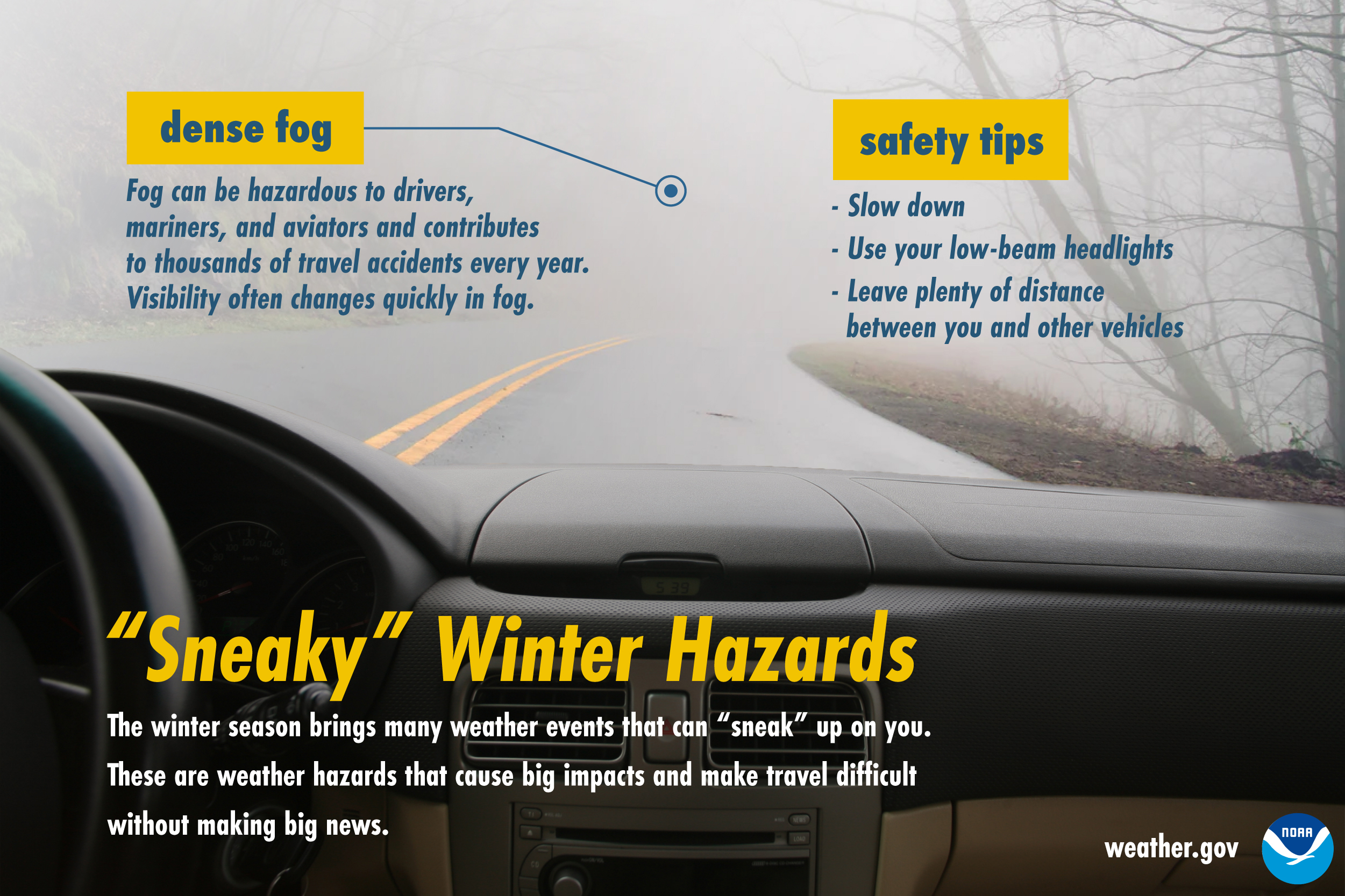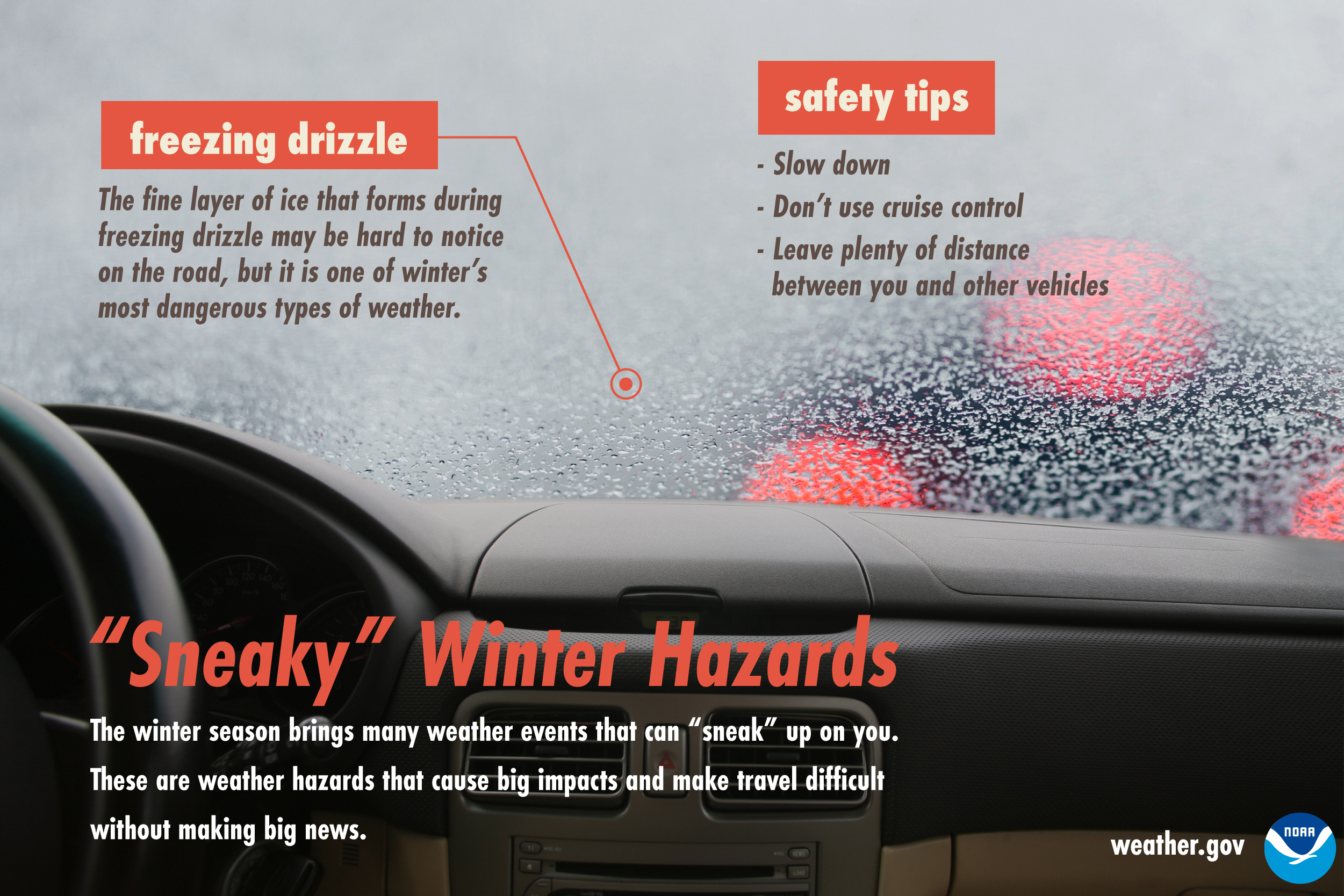Please help the NWS spread these messages on social media! Everyone is welcome to use the text and images provided below to help the NWS build a Weather-Ready Nation.
Facebook
While lots of snow in the middle of winter can certainly cause dangerous travel conditions, many times it’s the first little bit of snow of the season that can cause accidents. Be extra careful as you and other drivers adjust to driving in poor conditions. Slow down, don’t use cruise control, and keep your distance from other vehicles. Don’t let the first snow sneak up on you!
Twitter
While lots of snow in the middle of winter can cause dangerous travel conditions, the first little bit of snow of the season can also cause accidents. Be careful as you and other drivers adjust to driving in poor conditions. Don’t let the first snow sneak up on you! #WeatherReady

Facebook
Visibility can change quickly in fog, creating hazardous driving conditions. Slow down, use your low-beam headlights, and leave plenty of distance between you and other vehicles. Don’t let fog sneak up on you!
Twitter
Watch out for quickly changing visibility in fog. Use your low-beam headlights, slow down, and keep your distance from other vehicles. Don’t let fog sneak up on you! #WeatherReady

Facebook
Even on a nice winter day, the low sun angle can make driving hazardous. Freshly fallen snow can add more glare to your drive. Have a pair of sunglasses on hand, slow down, and leave plenty of distance between you and other vehicles. Don’t let sun glare sneak up on you!
Twitter
The low sun angle, especially combined with freshly fallen snow, can cause a glare that makes driving difficult. Keep a pair of sunglasses handy and slow down. Don’t let sun glare sneak up on you! #WeatherReady

Facebook
Rain may seem like less of a winter driving hazard than snow, but when temperatures are near freezing, that’s not the case. Ice can form quickly and make roads slick. In these conditions, slow down, don’t use cruise control, and keep plenty of distance between you and other vehicles. Don’t let this winter hazard sneak up on you!
Twitter
Rain may seem like less of a winter driving hazard than snow, but when temperatures are near freezing, that’s not the case. Ice can form quickly and make roads slick. Be extra careful in these conditions, and don’t let this winter hazard sneak up on you! #WeatherReady

Facebook
Snow squalls are short, intense bursts of snow and wind that can catch people off-guard. They can reduce visibility and cause dangerous travel conditions. If possible, avoid or delay travel until the squall passes. If you’re caught in one, slow down, turn on your headlights and hazard lights, and try to exit the road. Don’t let snow squalls sneak up on you!
Twitter
Snow squalls are short, intense bursts of snow and wind that can reduce visibility and cause dangerous travel conditions. Try not to travel during one. Don’t let snow squalls sneak up on you! #WeatherReady

Facebook
When surface temperatures are below freezing, drizzle will form a thin layer of ice on the roads. This difficult-to-see ice can cause very dangerous travel conditions. When it’s drizzling in the winter, slow down, don’t use cruise control, and keep your distance from other vehicles. Don’t let freezing drizzle sneak up on you!
Twitter
Freezing drizzle can cause difficult-to-see ice to form on roads, creating very dangerous travel conditions. When it’s drizzling in the winter, slow down! Don’t let freezing drizzle sneak up on you. #WeatherReady

Facebook
Even when it’s not precipitating, wet roads can quickly turn icy as temperatures dip below freezing. These unexpected slippery conditions can make driving hazardous. When roads look wet in the winter, stay cautious, slow down, and don’t use cruise control. Don’t let flash freezes sneak up on you!
Twitter
Wet roads can quickly turn to ice as temperatures fall below freezing. Slow down and don’t use cruise control. Don’t let flash freezes sneak up on you! #WeatherReady

Facebook
You wouldn’t think a little bit of rain could make the roads slippery, but after a long dry stretch, it can happen. This is because oil and debris accumulate on the road during the dry period. Once the rain starts falling, roads become slick. Slow down in these situations. This is one of those hazards that can sneak up on you!
Twitter
When it rains after a long dry stretch, roads can become surprisingly slippery. Don’t let this hazard sneak up on you! Slow down and don’t use cruise control. #WeatherReady
